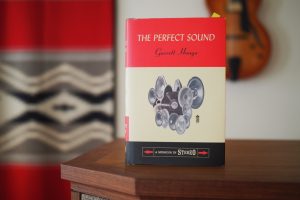As you probably know, I'm not just a writer and a long-time audiophile (I and my friends call ourselves "HiFi Crazies"), but a manufacturer of High-End audio cables, originally XLO, now RSX.
As such, to some of our HiFi brethren, that automatically makes me and anything I might say suspect. They insist—often based more on prejudicial "common sense" than on actual listening experience—that "wires is wires"; that the only things that can possibly affect the performance of a cable (or apparently any other electronic device) are Resistance, Capacitance, and Inductance ("R","C", and "L"); and that "High-End Cables" (cables said to allow for better system sound) and any number of other "tweaks" (things that are claimed to improve system performance but that may or may not defy "common sense"), are all just "snake oil and voodoo."
Actually, as the positive reviews of so many of such things have clearly shown, that's not necessarily the case: Some tweaks really do work and do exactly as they claim. There are others, though, whether part of our hobby or related to it, that fit quite nicely into the "Snake Oil and Voodoo" category.
Either that, or they're just plain nuts.
One of those is the turntable dust cover proposed years ago by Enid Lumley, one of the first female reviewers for the absolute sound. Enid pointed out, quite correctly, that
1) when you're playing records, the dust cover on your turntable can resonate along with the music and affect the sound of your system [absolutely reasonable];
2) the dust cover should therefore be removed and replaced with a cloth "tent" over your turntable to keep dust off but not "sing along with" the music [also reasonable, but not necessarily attractive];
3) the tent should be kept wet, to make any dust stick to it and help to "damp" (pun intended) any remaining resonances [still reasonable, but "iffy"]; and,
4) that, for best sonic results, only distilled water should be used [outright crazy!]
Another nutty one is the idea that still pops up occasionally that, by sticking little bits of stuff (dime-sized plastic discs, for example, or bigger wooden discs the size of hockey pucks, or little brass bowls: or whatever) to your equipment or putting them around your listening room, you can audibly improve your system's sound.
Just the math on that proves it to be absurd. Here's how:
Let's assume that your speakers have a perfectly hemispherical radiation pattern, and that, therefore, all frequencies radiate equally from a front point of origin at equal intensity in all forward directions to all parts of your listening room. Let's suppose, further, that we place one of those "magic discs or dealies" ("MDDs", for short) at a measured point exactly eight feet from your speaker. (For simplicity, let's use just one speaker and just one MDD—the results will be the same, either way.) Now let's make the first of a series of simple calculations to determine the surface area of the hemisphere of radiated sound coming off the speaker. That will be necessary for calculating exactly how much energy from the speaker will be available at any one square inch of the hemispheric radiating surface that we will designate, for purposes of illustration, to be the test area.
First, let's calculate the surface area of a sphere in inches. The formula is A=4πr2 and the radius to use is 96 inches. (8ft = 96 inches.) Using the formula, 96in. x 96in. = 9216 square inches (r2) That, times π = 28,953 square inches, which x 4 = 115,812 square inches as the surface area of a 16foot sphere (twice the stated 8ft test radius.) Now, let's divide that number by 2 to get the surface area of an 8ft deep hemisphere. That comes to 57,906 square inches, the total area that the speaker's forward energy is radiating into at 8ft from the point of origin.
That means, given the perfectly even dispersion pattern that we stipulated earlier, that every 1 square inch of that surface will receive exactly one fifty-seven thousand nine hundred and sixth (1/57,906 or 0.0000172 or a little under 2/1000ths of 1 percent) of the total sound energy coming into the room at 8 feet from the speaker.
Assuming that you like it loud and are playing your music at a full 1 Watt of output on super-sensitive, (100dB at 1 watt/1 meter) speakers, the amount of radiated energy available for a magic disc or dealie to work with will be just 0.000017 watts per square inch, before adjustment for the 245% increase in Inverse Square Law reference distance (98inches instead of 1 meter [39.37 inches] from the speaker). That adjustment will reduce the available energy by 82.2 percent (1/5.95 -1) and will leave the true net energy available at an 8ft distance as 0.0000028 watts per square inch.
Now, given that amount of power per square inch at a loud listening level, (most people listen at levels well below 100dB most of the time), and even generously assuming a big 4" by 4" (16 square inches) MDD, which is bigger than most such things on the market, what can a magic disc or dealie do to make your system sound better? Remember that, at the stated size and distance, it will have the princely total amount of 0.0000448 watts of power available to it to work with.
I haven't got a clue.
The only possibilities are:
1) it can absorb all or part of the energy impinging on it, or
2) It can reflect all or part of that energy, or
3) it can convert some (but never all) of the impinging energy into resonance (sound) at some frequency to add to or cancel the sound of the music (it can never convert ALL of it to resonance, though, as some of it will always be lost by conversion to heat, instead), or
4) it can do some combination of any or all of the above.
Whatever it is, nothing an MDD can do can possibly make enough difference, to even be heard against—let alone make a significant difference to—the sound of your system. In short, magic discs and dealies really are "snake oil and voodoo", and they're not alone.
Do you remember the "invention" by Peter Belt (a 1990s British audio tweaker) of a combination resistor/safety pin that could be pinned to the material of your sofa or listening chair to make your music sound better? Or how about the idea that, unlike outlining the edges of all of your CDs with green ink, which was a favorite tweak of the 1990s, the idea—also from Peter Belt, also from around the same time—that one single one-centimeter-long mark in purple ink on the edge of just one of your LPs would (if it were the proper shade of purple) make all of your LPs sound better?
Still one more was EarWaxTM, a product said to improve your hearing by lubricating your auditory canals to make it easier for sound to enter.
There are a lot stranger things in High-End audio than just cables, even if I do say it myself. Use your ears to find out for yourself which are real and which are not. Real improvement is real improvement, whatever its source. Snake oil, though, really is snake oil, so beware.
Happy HiFi!






































